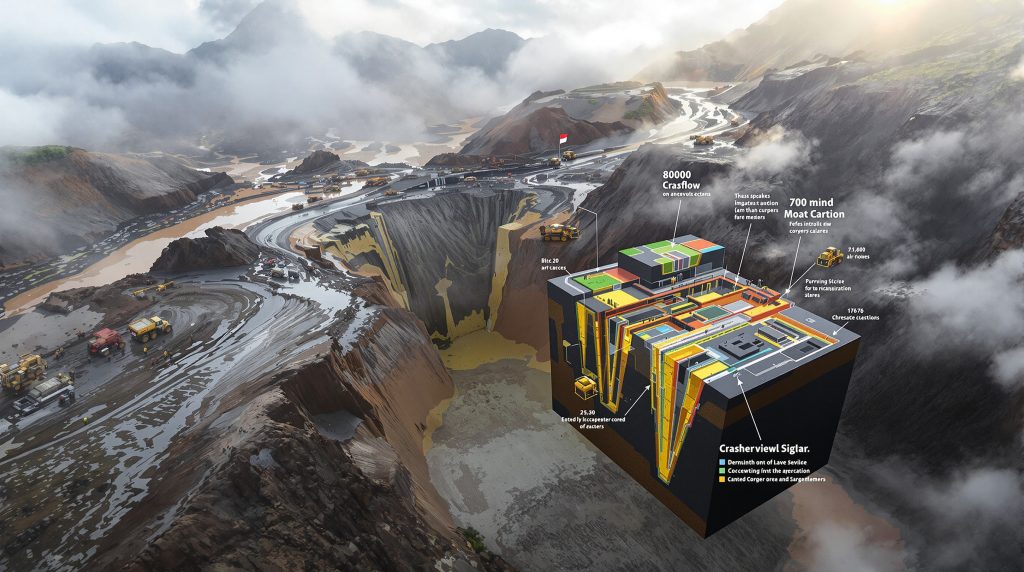Grasberg Mine Disaster: Ongoing Search Efforts Continue for Five Trapped Workers
The Grasberg copper and gold mine in Indonesia's Papua region remains the site of intensive rescue operations as teams work tirelessly to locate five miners who have been trapped underground for over three weeks. This disaster has not only devastated the local mining community but also sent ripples through global copper markets as one of the world's largest copper producers faces an extended production halt.
The Catastrophic Mudflow Event
On September 8, approximately 800,000 metric tons of wet material flooded underground sections of the Grasberg mine, trapping seven workers in what has become one of the most serious mining disasters in recent Indonesian history. To date, rescue teams have recovered two bodies, while five miners remain missing as search efforts continue under extremely challenging conditions.
The scale of this disaster prompted Freeport-McMoRan, the mine's operator, to declare force majeure—a contractual clause that exempts parties from obligations due to extraordinary circumstances—and lower its sales estimates for the remainder of the year.
"The search for our five colleagues who are still missing continues relentlessly," stated Katri Krisnati, a Freeport Indonesia spokesperson, highlighting the company's commitment to the ongoing rescue mission despite the significant challenges faced.
The Mine's Significance and Global Impact
The Grasberg mine complex, situated at an elevation of 4,270 meters above sea level in one of Indonesia's most remote regions, represents a cornerstone of global copper production. Prior to the disaster, the operation contributed approximately 3% of the world's copper supply, making it a critical component in global metals markets.
Following the suspension of all primary mining activities at the Grasberg Block Cave operation, global copper prices experienced a significant jump, underlining the mine's importance to international supply chains. Industry analysts note that continued disruption at this scale could potentially impact everything from electronics manufacturing to renewable energy projects worldwide.
The combination of the mine's remote location in Papua's highlands and the complex underground network of tunnels has further complicated both rescue efforts and the assessment of when operations might resume. With surging copper demand in global markets, the incident has raised concerns about supply constraints.
Current Rescue Operations Underway
Tactical Approach to Search and Rescue
Rescue teams have made considerable progress by excavating two separate access routes to reach potential survivor locations. These pathways serve as crucial arteries for both personnel and equipment to navigate through the affected areas.
The rescue operation has deployed specialized heavy equipment fitted with remote control systems, allowing teams to operate machinery in areas too hazardous for direct human presence. This technology enables the careful removal of debris while minimizing additional risk to rescue personnel.
Search efforts continue on a 24-hour schedule, with specialized underground rescue units working in rotating shifts to maintain continuous operations despite the physically demanding conditions. Each team typically operates for 4-6 hour periods before being replaced to ensure alertness and safety.
Significant Challenges Facing Rescue Teams
The rescue operation faces multiple complex challenges that have slowed progress despite the urgency of the situation. Primary among these is the ongoing movement of wet material, which creates unstable conditions and poses significant risks of secondary collapses.
"This high-risk rescue process also faces significant challenges due to the movement of wet material," Freeport's statement confirmed, underscoring one of the most dangerous aspects of the operation.
As search areas deepen, air circulation becomes increasingly limited, creating respiratory hazards for rescuers who must carefully monitor oxygen levels and carry supplemental breathing equipment. The combination of restricted visibility, difficult terrain, and unstable ground conditions further hampers equipment deployment and rescue efforts.
The psychological pressure on rescue teams intensifies as time passes without contact with the missing workers, requiring careful management of fatigue and stress among personnel while maintaining the operational tempo needed for a successful rescue. Recent mining industry trends have emphasized improved safety protocols, yet disasters like this highlight continuing risks.
Why The Rescue Operation Presents Extraordinary Difficulties
Technical Complexities of Underground Rescue
The sheer volume of displaced material—800,000 metric tons—creates an enormous search area that must be methodically cleared using precision techniques. This volume equates to approximately 40,000 standard dump truck loads, providing perspective on the magnitude of material rescue teams must navigate through.
Underground rescue operations face significantly greater complexities than surface rescues due to the three-dimensional nature of mine networks. Limited access points, complex ventilation systems, and the need to maintain structural integrity all contribute to the methodical pace required for safe operations.
Geotechnical experts working with rescue teams must continuously assess ground stability as excavation progresses, using specialized monitoring equipment to detect early warning signs of potential secondary collapses or shifts in the debris field.
Safety Protocols Necessarily Slowing Progress
Each new access route requires comprehensive engineering assessment before teams can proceed, involving geotechnical analysis, structural evaluation, and ventilation planning. These essential safety measures, while time-consuming, prevent further casualties among rescue personnel.
Remote-controlled equipment operates significantly more slowly than manual operations but provides critical protection for rescue teams by allowing work to continue in areas with higher collapse risks or poor air quality. These systems require specialized operators and frequent maintenance to ensure reliability in the challenging underground environment.
Regular safety pauses are mandated to check the structural integrity of rescue tunnels, with specialized teams conducting comprehensive assessments at predetermined intervals or whenever unusual ground movement is detected. These necessary precautions inevitably extend the timeline for reaching the trapped miners.
Survival Prospects For The Missing Miners
Potential Survival Factors
Modern underground mining operations typically incorporate emergency refuge chambers stocked with essential supplies specifically designed to support trapped miners during disasters. These self-contained units can potentially provide breathable air, water, and basic provisions for extended periods.
The Grasberg mine, like most major operations, implements standardized safety protocols that include strategically positioned emergency air and water caches throughout the underground network. These resources could potentially extend survival times depending on their accessibility to the trapped workers.
Experienced miners receive extensive training in emergency survival techniques, including air conservation, emergency response protocols, and psychological coping strategies. This training could prove crucial for anyone trapped in survivable conditions.
Mining experts note that certain underground configurations can naturally maintain breathable air pockets following collapses, especially in areas with active ventilation systems or natural fissures that allow limited air exchange with other mine sections.
Communication Attempts
Rescue teams are employing specialized acoustic detection equipment capable of identifying even faint sounds through dense material. These highly sensitive systems periodically halt all rescue activity to create the silence necessary for effective detection.
Strategic drilling operations aim to create small communication channels to potential survival zones, allowing for the insertion of microphones, cameras, or basic supplies if survivors are located. These narrow boreholes can be created more rapidly than full rescue tunnels but require precise targeting based on mine maps and rescue team assessments.
Despite these efforts, no confirmed communication with the missing workers has been reported since the incident occurred, complicating rescue planning and raising concerns about survival prospects as the search extends into its fourth week. Similar challenges were faced during the recent New Zealand tunnel collapse, where underground rescue operations proved exceptionally difficult.
The Company's Response To The Disaster
Freeport-McMoRan's Emergency Response
Freeport-McMoRan immediately suspended all mining activities at the main Grasberg Block Cave upon the initial incident, prioritizing rescue operations over production concerns. This decisive action freed up personnel, equipment, and access routes for emergency responders.
The company mobilized specialized rescue teams and equipment from across its global operations, including mining rescue experts with experience in similar emergency situations. This international response brought together personnel with diverse expertise in complex underground rescue scenarios.
Regular updates have been provided to families of the missing workers through dedicated liaison officers, while public statements detail rescue progress and ongoing challenges. The company has established support services for affected families, including accommodation, counseling, and financial assistance during the crisis period.
"The search for our five colleagues who are still missing continues relentlessly," emphasized Freeport Indonesia spokesperson Katri Krisnati, reinforcing the company's commitment to the rescue effort despite the significant challenges and time elapsed.
Operational and Business Impact
The force majeure declaration on copper deliveries from Grasberg represents a significant business disruption for both Freeport-McMoRan and its customers. This legal provision acknowledges the company's inability to fulfill contractual obligations due to circumstances beyond its control.
Production forecasts have been substantially reduced for the remainder of the year, with potential impacts extending into next year depending on the ultimate damage assessment and recovery timeline. Industry analysts estimate that each week of complete shutdown represents approximately 8,000 tons of lost copper production.
Limited operations continue at approximately 30% capacity in smaller adjacent mining blocks that were unaffected by the mudflow, allowing for some continued production while rescue efforts remain the priority in the main Grasberg Block Cave.
The company has emphasized that production recovery plans remain entirely secondary to rescue efforts, with no timeline for resumption of full operations until the status of all missing workers has been determined and comprehensive safety assessments completed. According to official company statements, the focus remains exclusively on the search and rescue operation.
Indonesian Government's Involvement
Government Response and Oversight
Indonesia's Ministry of Energy and Mineral Resources has deployed senior officials to the site to monitor rescue operations and provide government support where needed. These representatives serve as a direct communication channel between the operation and national authorities.
Safety inspectors from multiple government agencies are reviewing emergency response procedures and compliance with existing regulations. Their findings will likely inform both immediate rescue tactics and longer-term safety improvements.
Local and regional emergency services have been coordinated through government disaster management teams, providing additional personnel and resources to support the primary mining rescue specialists. This multi-agency approach helps address both the technical rescue challenges and broader community impacts.
Regular briefings to senior government officials ensure transparency and accountability throughout the rescue operation. These updates include honest assessments of progress, challenges, and resource needs.
Regulatory Implications
Mining safety experts anticipate a comprehensive review of underground mining safety regulations will follow this incident, with particular focus on mudflow risk assessment, emergency response capabilities, and communications systems. Previous major mining incidents worldwide have typically led to significant regulatory enhancements.
Increased scrutiny of wet material management protocols will likely affect similar operations throughout Indonesia's mining sector. The massive volume of material involved in this incident has raised questions about monitoring systems for detecting early warning signs of potential instability.
Government assessments of emergency response capabilities at other major mining operations have reportedly been accelerated, with particular attention to refuge chamber placement, emergency supplies, and evacuation protocols. These proactive reviews aim to prevent similar situations at other sites.
Historical Context of Mining Rescues
Comparative Analysis of Previous Mining Disasters
The mining industry has witnessed remarkable survival stories that provide context for the current Grasberg situation. Most notably, the 2010 Chilean mining accident saw 33 miners rescued after spending 69 days trapped underground—a case that revolutionized underground rescue techniques and demonstrated the possibility of survival under extreme conditions.
The Quecreek Mine rescue in Pennsylvania (2002) demonstrated how modern technology could locate and rescue nine miners trapped by flooding after 78 hours underground. This operation pioneered several techniques now standard in mining rescue operations, including specialized drilling approaches and communication systems.
Technology advancements have significantly improved rescue capabilities compared to earlier decades, with innovations in remote sensing, communications, drilling precision, and life support systems all contributing to more effective responses. These technological improvements continue to evolve with each major incident.
Statistical Survival Factors
Survival duration in underground emergencies depends primarily on several key factors: access to water (the most critical element), air quality (particularly oxygen levels and absence of toxic gases), temperature conditions (hypothermia risk in wet environments), and the psychological resilience of those trapped.
Modern mines incorporate multiple safety features specifically designed to extend survival windows, including refuge chambers with independent air supplies, emergency food and water caches, and communications systems designed to function during disasters. The effectiveness of these systems depends on their proximity to workers during an emergency event.
Medical experts specializing in survival physiology continue to advise rescue teams on survival probability assessments based on estimated conditions in different sections of the affected mine. These assessments help prioritize search areas and inform rescue strategies as time progresses.
Long-Term Implications For Mining Safety
Industry-Wide Safety Learnings
The Grasberg mine disaster rescue updates continue to provide valuable insights that will likely prompt a comprehensive review of mudflow risk assessment protocols throughout the global mining industry. Previous major incidents have typically resulted in technological and procedural advances that become industry standards within a few years of the triggering event.
Enhanced monitoring systems for detecting potential ground instability will receive renewed focus, potentially accelerating the adoption of advanced sensor networks, artificial intelligence analysis of subtle warning signs, and more conservative threshold triggers for preventative evacuations.
Improved emergency response training specifically targeting similar scenarios will likely be developed and incorporated into standard safety curricula for underground mining operations worldwide. These training modules typically combine lessons learned from multiple incidents to create more comprehensive preparation.
Future Preventative Measures
A reassessment of underground refuge chamber placement and supplies appears inevitable following this incident, with particular attention to their positioning relative to areas with higher mudflow risk. Regulatory changes may mandate increased redundancy in these critical safety systems.
Enhanced communication systems designed to maintain contact during emergencies similar to the Grasberg incident are already under development within the mining technology sector. These systems aim to create more reliable communication channels resistant to the types of disruption experienced in this disaster.
The development of specialized rescue equipment specifically designed for mudflow incidents represents another likely outcome, potentially including more capable remote-operated vehicles, advanced debris clearing systems, and improved personal protective equipment for rescue personnel.
Recovery Prospects For The Grasberg Mine
Projected Timeline and Process
No official restart date has been announced while rescue operations continue, with company officials emphasizing that production considerations remain entirely secondary to the ongoing search for missing workers. This approach aligns with both humanitarian priorities and regulatory requirements.
Comprehensive engineering assessments of affected areas will be required before production can resume, involving structural stability analysis, ventilation system restoration, and potential redesign of vulnerable sections. This assessment process typically takes weeks to months depending on the extent of damage.
A phased approach to operations restart appears most likely once safety is confirmed, beginning with areas furthest from the affected zones and gradually expanding as inspections are completed and necessary modifications implemented. This methodical approach balances production recovery with safety considerations.
Full production recovery could potentially require 6-12 months depending on the final damage assessment, with initial operations likely running at reduced capacity while remediation work continues in parallel. The complex nature of underground mining systems requires careful reintegration of all operational elements.
Economic Implications
Continued pressure on global copper prices is expected while Grasberg production remains limited, potentially affecting manufacturing costs across multiple industries dependent on copper inputs. Market analysts note that prolonged disruption at this scale could accelerate development of alternative copper sources.
Supply chain adjustments by customers dependent on Grasberg output have already begun, with procurement teams securing alternative supplies, often at premium prices. These adjustments ripple through manufacturing sectors from electronics to construction.
Market analysts are closely monitoring production recovery announcements, with particular attention to the phasing of capacity restoration and any indications of long-term output impacts. These assessments inform investment decisions across both mining and manufacturing sectors, with some investors seeking new copper investment insight from alternative projects.
Understanding Mining Rescue Operations
Typical Survival Scenarios
Survival duration varies significantly based on access to water, air quality, temperature conditions, and the presence of emergency supplies. Modern mines are equipped with refuge chambers containing water, food, and oxygen that can potentially extend survival for days or weeks under optimal conditions.
Psychological factors play a crucial role in survival scenarios during extended isolation. Mining safety training increasingly incorporates psychological resilience techniques specifically because maintaining mental clarity and emotional stability dramatically improves survival prospects in extended entrapment situations.
Medical research on survival in confined spaces informs both rescue planning and the design of emergency shelters. This specialized field combines physiology, psychology, and practical experience from previous mining emergencies to continuously improve survival systems and rescue protocols.
Safety Systems in Modern Mining
Large underground operations typically implement multiple layered safety systems including emergency refuge chambers, redundant communication networks, environmental monitoring, ground stability sensors, clearly marked evacuation routes, and regular emergency drills. These systems work together to prevent disasters and mitigate impacts when they occur.
Workers carry personal emergency equipment and receive regular training in survival protocols specific to their mine's geography and potential hazards. This individualized approach recognizes that different mining operations face distinct challenges requiring tailored emergency responses.
Modern mine design incorporates safety considerations from the earliest planning stages, with emergency response scenarios analyzed and addressed before production begins. This proactive approach represents a significant evolution from historical mining practices where safety systems were often retrofitted to existing operations.
The Grasberg incident will likely accelerate the integration of advanced technologies into mining safety systems, potentially including artificial intelligence monitoring, improved remote sensing capabilities, and more sophisticated early warning systems for detecting subtle changes in ground conditions before catastrophic failures occur. According to Jakarta Globe reports, the length of the search has prompted calls for industry-wide reviews of emergency protocols across Indonesia's mining sector.
Want to Identify the Next Big Mineral Discovery Before the Market?
Discovery Alert's proprietary Discovery IQ model delivers real-time notifications when significant mineral discoveries are announced on the ASX, giving you a crucial market advantage. Visit our discoveries page to see how past mineral discoveries have generated substantial returns and start your 30-day free trial today.




